The Climate Resilience Workforce Act
Air Date: Week of April 8, 2022
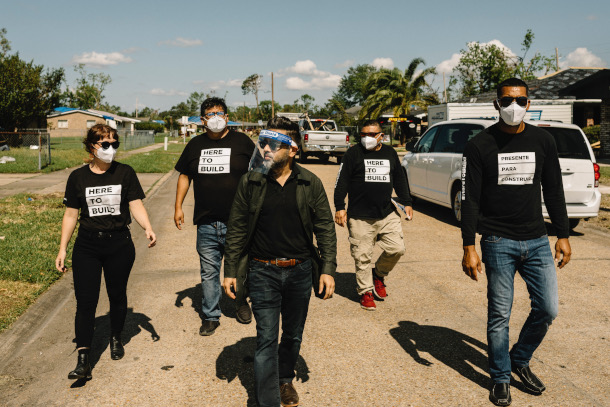
Saket Soni (third to the right) is a labor organizer and human rights strategist. He is founder and director of Resilience Force, a national initiative to transform America’s response to natural disasters by strengthening and securing America’s resilience workforce. (Photo: Courtesy of Resilience Force)
Democratic Representative Pramila Jayapal of Washington State recently introduced the Climate Resilience Workforce Act, which aims to protect disaster recovery workers, grow the workforce, and prioritize the communities most in need of federal assistance when climate disasters strike. Saket Soni is the Executive Director of Resilience Force and helped draft the bill. He joins Host Jenni Doering to discuss.
Transcript
DOERING: A new bill in Congress aims to protect disaster recovery workers and create jobs. The Climate Resilience Workforce Act was introduced in the House in February by Democratic Representative Pramila Jayapal of Washington State. There haven’t been any hearings on the bill yet but the goal is to establish a $15 minimum wage and ensure healthcare coverage. And it will prioritize the communities most in need of federal assistance when climate disasters strike. It also addresses the rising costs of recovery. In 2021 alone there were 20 separate climate related disasters that each exceeded $1 billion dollars in losses each. Saket Soni is the Executive Director of Resilience force and helped draft the Climate Resilience Workforce Act.
SONI: What this bill will do is protect the current workers with labor standards, health and safety standards, but it'll also add millions of jobs to this workforce. It'll spend money, send it to cities, states and tribal governments and help them build their own resilience workforce locally, adding lots and lots of people to this workforce and setting them up for long term careers.
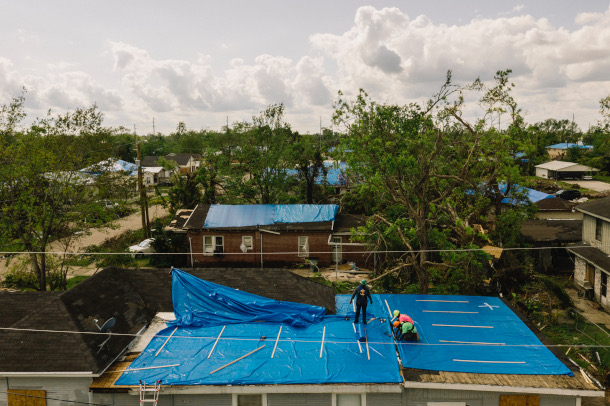
Blue tarp is often used after storm damage because it provides a temporary covering to help reduce further damage to property until permanent repairs can be made. Some homeowners and landlords are eligible for Operation Blue Roof, a program offered by FEMA through the U.S. Army Corps of Engineers. (Photo: Courtesy of Resilience Force)
DOERING: I think you mentioned millions of jobs. These workers can come in when there is a disaster, and they can help rebuild a community. And to what extent could they also help implement climate adaptation, you know, not just rebuilding the same way as before, but rebuilding better and maybe even weatherizing homes and other things like that on a longer term basis?
SONI: Well, absolutely, that's a huge part of the need. And I think that's a big part of the intention of representative Jayapal's Climate Resilience Workforce Act. Congress has already passed a trillion dollars over 10 years to be spent on infrastructure that can include and should include not just money for bridges and roads, but for climate adaptation, and climate resilience. A lot of that money should actually go to West Virginia, where Senator Manchin has a state that experiences flooding year after year, historic flooding, you know, homeowners are in a constant crisis. You can imagine people who transition out of the coal industry, getting good high paying jobs, doing climate adaptation work right in West Virginia, and across the country. So what you could actually have is something akin to what already exists in New Orleans.
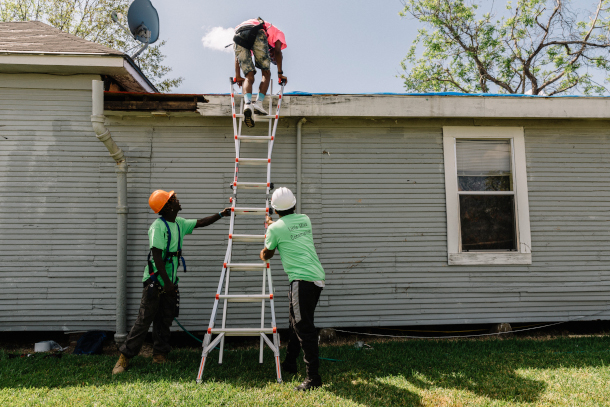
Reconstruction workers climbed a ladder onto a roof after it was damaged from storm damage from the 2020 Hurricane Laura in the Lake Charles Area. (Photo: Courtesy of Resilience Force)
In New Orleans, the mayor has created a resilient score, taking people who lost their jobs during the pandemic in the service sector, and turning them into a permanent core of resilience workers who are working on adaptation, both in relation to climate change, and the pandemic. These are workers who used to earn $7.25 an hour, the federal minimum wage, and are now on a path to $18 an hour doing this kind of work. So, you know, these are good long term jobs. The idea that you need to build back better, actually, isn't an idea of Congress. It's something that most homeowners would agree on. Most people in the United States know that their roofs were constructed 15, 20 years ago. And they actually need not just restoration, but a much stronger home to face the next season's hurricanes, floods and fires. So you can imagine, you know, skilled armies of workers who do climate adaptation work in American cities, and in rural areas, year after year.
DOERING: So early on, in his term, President Biden put forth the justice 40 initiative pledging to direct 40% of climate spending to underserved places, including communities of color and small towns. How fairly has disaster recovery funding been allocated historically? And how would the Climate Resilience Workforce Act remedy this?
Whether it's hurricanes, tornados, or fire, we're ready to meet the challenges that disasters pose and help communities recover.
— Resilience Force (@ResilienceForce) April 7, 2022
From California to the Gulf Coast, Resilience Workers are #HereToBuild. pic.twitter.com/HqdWDtDOJi
SONI: Disaster recovery has become a hidden driver of inequality in America. If you follow the money, you see that so much disaster recovery money ends up helping white wealthy homeowners, while disasters have the opposite impact on rural people, people of color renters and low income homeowners. And in part that's because disaster recovery is much more likely to help the insured rather than the uninsured. Now, there's an alternative to this. There's another way of doing it. And the Climate Resilience Workforce Act shows us how. First, it sends money through grants to states, counties, cities, tribal governments, across the United States. And so you can choose places that are prone to disaster, but not as wealthy. You can choose places that are prone to disaster and really need a way to help local people after disasters connect to the good jobs in disaster recovery. Secondly, the bill removes barriers to employment in climate resilience jobs. For the people who constantly face these barriers. It makes these jobs accessible for people with criminal records through better band-the-box provisions. It creates a pathway to to citizenship for undocumented people in these jobs. So those are ways in which it really builds equity, racial equity for workers. The other thing that the bill does is create the training programs. And in recent years, there's been a resurgence of conversation and thinking about the Civilian Conservation Corps and other kinds of large scale jobs programs. But the thing is that for low income people to actually get on those pathways, those programs have to pay well. It’s not possible to enter a job pathway, if all it provides is, you know, the equivalent of a low paid internship. And so this bill would actually fund training programs that connect young people to well paid jobs.
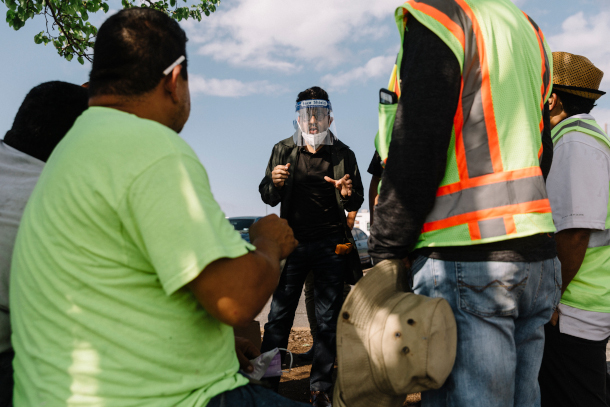
Saket Soni talks to resilience workers during repairs after the 2020 Hurricane Laura. (Photo: Courtesy of Resilience Force)
DOERING: Saket, how bipartisan is the idea of of putting funding towards climate resilience?
SONI: Well, I can tell you this, if you come with me, to an American city or town, hit by disaster, whether it's in Kentucky, where I was in December, after the tornadoes tore through Appalachia or in Louisiana, where two hurricanes in two years, uprooted tens of thousands of families, you know, sent them away from their homes, destroyed their homes and their their livelihoods. In these kinds of communities, climate resilience is an urgent need. And it's not a political conversation. It's bipartisan in the sense that politics doesn't matter. People after disasters, cooperate with each other, they help each other that's an American value. You know, I've seen Republican mayor's ask the police in their towns, to stop checking for documents so that undocumented people can pass through safely and go to their workplaces to rebuild homes. I've seen dinners take place between migrant workers and their US born beneficiaries, the homeowners who own the homes that the workers are fixing. And there are expressions of gratitude on each side. So that's what disaster recovery looks like on the ground. And I've never found a situation where politics trumps the needs of recovery. That's the way it needs to be in Washington. That's the way it needs to be in our national conversation.
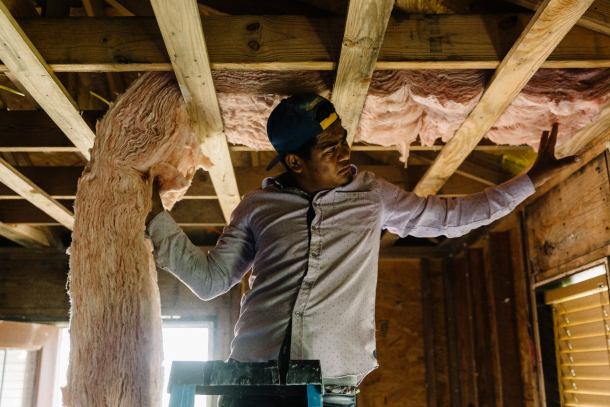
Resilience workers travel across the country chasing disasters with little in the way of federal occupational health and safety protections. (Photo: Courtesy of Resilience Force)
DOERING: Saket Soni is director of Resilience Force. Thank you so much Saket.
SONI: Thank you.
DOERING: By the way the Climate Resilience Workforce Act has yet have a hearing but Congress will need to consider something like this as devastating climate disasters just keep coming.
Links
Learn more about Resilience Force
Grist ”Undocumented Workers are Cleaning Up Our Climate Disasters. A New Bill Would Protect Them”
Read the Climate Resilience Workforce Act
Watch a panel discussion about the Climate Resilience Workforce Act
Living on Earth wants to hear from you!
Living on Earth
62 Calef Highway, Suite 212
Lee, NH 03861
Telephone: 617-287-4121
E-mail: comments@loe.org
Newsletter [Click here]
Donate to Living on Earth!
Living on Earth is an independent media program and relies entirely on contributions from listeners and institutions supporting public service. Please donate now to preserve an independent environmental voice.
NewsletterLiving on Earth offers a weekly delivery of the show's rundown to your mailbox. Sign up for our newsletter today!
 Sailors For The Sea: Be the change you want to sea.
Sailors For The Sea: Be the change you want to sea.
 The Grantham Foundation for the Protection of the Environment: Committed to protecting and improving the health of the global environment.
The Grantham Foundation for the Protection of the Environment: Committed to protecting and improving the health of the global environment.
 Contribute to Living on Earth and receive, as our gift to you, an archival print of one of Mark Seth Lender's extraordinary wildlife photographs. Follow the link to see Mark's current collection of photographs.
Contribute to Living on Earth and receive, as our gift to you, an archival print of one of Mark Seth Lender's extraordinary wildlife photographs. Follow the link to see Mark's current collection of photographs.
 Buy a signed copy of Mark Seth Lender's book Smeagull the Seagull & support Living on Earth
Buy a signed copy of Mark Seth Lender's book Smeagull the Seagull & support Living on Earth

